

Aztecs (Mexica) During the twelfth century AD the Mexica were a small and obscure tribe searching for a new homeland.
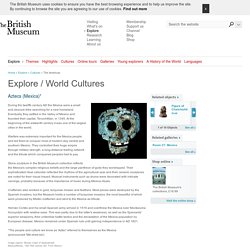
Eventually they settled in the Valley of Mexico and founded their capital, Tenochtitlan, in 1345. At the beginning of the sixteenth century it was one of the largest cities in the world. Warfare was extremely important for the Mexica people and led them to conquer most of modern-day central and southern Mexico. They controlled their huge empire through military strength, a long-distance trading network and the tribute which conquered peoples had to pay. Stone sculpture in the British Museum collection reflects the Mexica's complex religious beliefs and the large pantheon of gods they worshipped. Craftsmen also worked in gold, turquoise mosaic and feathers.
Hernán Cortés and his small Spanish army arrived in 1519 and overthrew the Mexica ruler Moctezuma Xocoyotzin with relative ease. The Aztec Empire. THE AZTEC EMPIREOriginsEmpire expansionismAcatitlanMalinalcoTenayuca PyramidTenochtitlanTexcotzingoTlatelolcoMoctezumaTepanec EmpireTriple AllianceArchaeological Sites in Mexico City ARTIFACTSAnthropomorphic SculpturesAtlantean Warrior ColumnsBallgameBraziersDishwareFiguresFunerary UrnsMusical InstrumentsJewelryMasksVessels ARTIFACTS OF ROYALTYTizoc StoneStone of Moctezuma ICoronation Stone of Moctezuma IIHeaddress of Moctezuma IIFeathered ShieldsTemple Stone CALENDARThe Aztec CalendarAztec CalendarMexica/Aztec Calendar Systems CLERGY EPIGRAPHERSSahagun, Bernardino de (1500-1590)Parry, J.
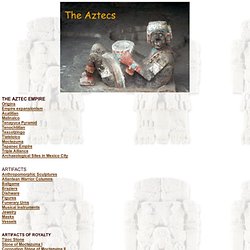
H. CODICESAubin CodexAzcatitlan CodexBorbonicus CodexBorgia CodexDuran CodexFejervary-MayerFlorentine CodexMendoza CodexLienzo de Tlaxcala HUMAN SACRIFICEHuman SacrificeNew Fire CeremonySacrificial knives MUSEUM EXHIBITSNational Museum of Anthropology, Mexico CityChicago Field Museum. Aztec carvings tell story of cosmic battle. Aztec History. Moctezuma's Feather Crown. Moctezuma's Feather Crown (Copilli Queztalli) Moctezuma's Feather Crown is now in a Museum in Austria.
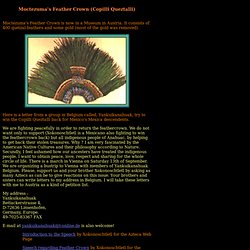
It consists of 400 quetzal-feathers and some gold (most of the gold was removed). Here is a letter from a group in Belgium called, Yankuikanahuak, try to win the Copilli Queztalli back for Mexico's Mexica descendents. We are fighting peacefully in order to return the feathercrown. We do not want only to support (Xokonoschtletl is a Mexicano also fighting to win the feathercrown back) but all indigenous people of Anahuac, by helping to get back their stolen treasures. My address : Yankuikanahuak Bettackerstrasse 4, D-72636 Linsenhofen, Germany, Europe. 49-7025-83367 FAX E-mail at yankuikanahuak@t-online.de is also welcome! The Aztec Culture. Undefined This page was created for ATID 410-1 at North Dakota State University.

Created by Chris Althoff, Randy Habeck, Brad Hegseth. Aztec Calendar: Today in the Aztec and Maya Calendar. Mexconnect: The Aztecs. Dale Hoyt Palfrey By the 13th century the entire region, then called the Valley of Anahuac, was occupied by assorted rival city-states.

Among the last to arrive on the scene was the nomadic tribe of the Mexica (pronounced may-SHEE-ka), more commonly known as the Aztecs, who ended a long migration from their northern homeland, Aztlan, by settling in the Valley marshlands. The Aztecs considered themselves the chosen people of the sun and war god Huitzilopochtli. After coming upon an eagle perched on a cactus devouring a snake, a sign foretold in ancient tribal prophecy, the Aztecs founded Tenochtitlan, their capital, on an island in Lake Texcoco.
They sustained themselves there for half a century by acting as mercenaries for the mighty Tepanecs of Azcapotzalco, but eventually rose up against their rulers, effectively seizing power over the valley. According to Aztec belief, their world existed under the fifth sun, four previous ones having been destroyed by various cataclysms. Mexicolore. Aztec. Large ceramic statue of an Aztec Eagle Warrior The Aztec /ˈæztɛk/[1] people were certain ethnic groups of central Mexico, particularly those groups who spoke the Nahuatl language and who dominated large parts of Mesoamerica from the 14th to 16th centuries.
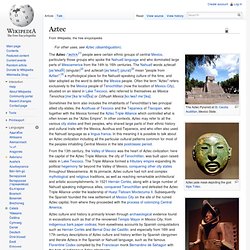
The Nahuatl words aztecatl [asˈtekat͡ɬ] (singular)[2] and aztecah [asˈtekaʔ] (plural)[2] mean "people from Aztlan",[3] a mythological place for the Nahuatl-speaking culture of the time, and later adopted as the word to define the Mexica people. Aztec Architecture. The Aztecs/Mexicas. The Aztecs / Mexicas were the native American people who dominated northern Mexico at the time of the Spanish conquest led by Hernan CORTES in the early 16th century.
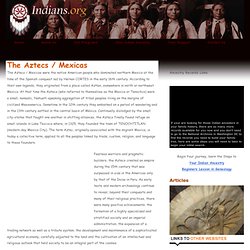
According to their own legends, they originated from a place called Aztlan, somewhere in north or northwest Mexico. At that time the Aztecs (who referred to themselves as the Mexica or Tenochca) were a small, nomadic, Nahuatl-speaking aggregation of tribal peoples living on the margins of civilized Mesoamerica. Aztecs - Snaith Primary. Aztecs Homework - Woodlands School.